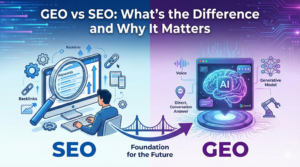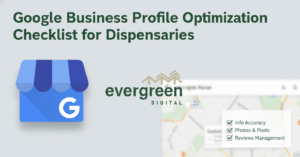In this special feature for Evergreen SEO Services, we explore the evolving relationship between SEO and paid search. Host Jeremy Rivera sits down with PPC expert Lisa Raehsler to discuss AI’s impact on search results, cross-channel marketing strategies, and economic considerations for digital campaigns. As specialists in comprehensive digital marketing solutions, we’re committed to bringing you valuable insights that bridge the gap between organic and paid search.
Top 5 Killer Quotes from Lisa Raehsler
“Those views and interactions that might seem less valuable than a click through the website are very valuable in their own way because we can create remarketing lists from them.” – on the value of social media engagement
“If you just do one [channel], you’re going to be fine, but you can get a lot farther if you can get all of these channels to work together in a strategic way.” – on cross-channel marketing
“If your keyword themes are more product focused or farther down the funnel, you’re more likely to have ads there than an AI overview.” – on when AI overviews appear vs. ads
“I look for somebody who is all in, who is really dedicated to making it work… Making sure we have a stable foundation from the beginning is crucial.” – on what she seeks in new clients
“The more data you have, the richer data set that you have, the more valuable those lookalike audiences are. They can look at all of these different signals to match them up a little bit better.” – on the importance of first-party data
Key Insights Summary
- AI’s Impact on PPC: AI overviews in search results tend to appear for informational queries, while product-focused keywords farther down the funnel are more likely to trigger ads instead of AI summaries.
- Cross-Channel Integration: The most effective digital marketing strategies combine multiple channels – PPC, SEO, social media, and email marketing – working together strategically rather than in isolation, similar to our approach at Evergreen Digital.
- Remarketing Revolution: Remarketing has evolved significantly beyond simply following website visitors; now marketers can create sophisticated audience lists based on various interactions across platforms.
- First-Party Data Value: Collecting customer emails and first-party data is crucial for creating effective lookalike audiences that help reach new potential customers with similar profiles.
- Keyword vs. Audience Focus: Pure keyword campaigns are showing decreased effectiveness, while campaigns that blend keyword targeting with audience targeting are gaining more impressions and exposure.
- Competitive Targeting Strategy: For new brands lacking name recognition, targeting competitors’ branded keywords can be effective as those searchers already understand the product/service category.
- Microsoft’s Ad Evolution: Microsoft is testing contextual ads in Copilot based on entire conversation threads rather than just keywords, showing how AI is transforming PPC targeting.
- Economic Adaptation: Brands should regularly audit their marketing strategies to ensure messaging is appropriate for current economic conditions and adjust targeting accordingly. This approach applies to specialized markets like the cannabis industry.
Introduction to Lisa Raehsler and Big Click Co.
Jeremy: Hello and welcome to the Unscripted SEO podcast. I’m here with Lisa Raehsler and we’re going to get into the intersection of SEO, PPC, and probably given current events, talking a little bit about marketing through adverse times. So give us a little bit of your back story, your current company and what you’ve been working on.
Lisa: Sure, well thanks for having me. I’m really excited to be here and have this conversation with an SEO because that is not my specialty. So I think we have some complementary skills here. My company is Big Click Co. For 14 years, I’ve had my own business and I focus on doing PPC ads, mostly Google ads, Microsoft ads, and social platforms depending on the client and the type of product they offer. I’m really interested in how things are going with AI and how that has been moving quickly forward in the past couple years and how it’s influencing how we do digital ads.
Impact of AI Overviews on Ads and Click-Through Rates
Jeremy: I think there’s a couple of stories. There’s a couple of overlapping pieces there because if we come back to the fundamentals of SEO and PPC is that we have this search experience, and Google is putting up this live auction on top of what it’s displaying. It’s kind of putting out this beautiful stall, you could think of it that way. It’s like a marketplace bizarre where vendors are here because you were interested in ham, and they give preferential treatment to the couple of merchants who come along and say, can I get a prime spot for this? Sort of like how luxury sites such as Cabo Luxury might position themselves in travel searches.
But with AI overviews, suddenly in front of all the other stalls is a Google laundry list that is basically a rehash of what the other stalls already have. From the pay-per-click side, how do paid ads work when it comes to surfacing information in an AI overview? What impact have you seen on click-through rates or adjustments to campaigns specifically tied to those AI overviews?
Lisa: They don’t give us reporting on the AI overviews. When the ads are showing up there in relation to any other search results, they don’t blend that information for us. It’s hard to say, and it’s one of those things where you kind of manually have to go and do some research on your own as to where you’re showing up in the results. Microsoft ads is starting to test ads that are actually integrated with your AI query in Co-Pilot. The AI overviews that are showing up in Google seem to be more informational. If your keyword themes are more product focused or farther down the funnel, you’re more likely to have ads there than an AI overview.
Microsoft Copilot Ad Integration
Jeremy: I am curious about what it’s going to look like with that Microsoft Copilot test case of integrating those ads into those results. Do you know if they have very conspicuous ad branding on them or call-outs, or is it kind of more googly of trying to get by as sneakily as possible?
Lisa: They’re doing a really limited test right now. What I saw was an example of ads showing at the bottom in co-pilot, not in Bing. Rather than the concept of them being keyword focused, the ads are being served based on the context of the entire conversation.
Jeremy: That seems to abdicate even more control to a murky system of “trust us, we’ll get it in front of the people that matter.” It kind of feels a bit black box.
Lisa: Right, and that’s especially true when they’ve been really pushing broad match more. That is just a much broader way for your keyword to match up to the queries, so there’s more room for mistakes or for your ad to be triggered by irrelevant searches. At the same time, they’re promoting PMAX ad campaign types more, which appear in search results but also across Google properties like Gmail and display ads on partner sites. With all these different variables, it’s hard to say what the absolute reason is for what’s going on with click-through rates.
Campaign Efficiency and Budget Impact
Jeremy: Are you seeing a trend towards more added efficiency with these developments or are people having to spend more to get the same amount? I’ve noticed this becoming a bigger question for clients who run DIY marketplaces like Maker Table who are trying to optimize their ad spend.
Lisa: I’m not seeing much of a difference in the budget, but what I’m seeing is that purely keyword campaigns are having a little bit of trouble, maybe being shown a little bit less. There’s less activity, whereas if you’re pairing the keyword searches with audiences and blending more targeting types, they’re getting more exposure and more impressions.
Social Media Platforms and Ad Strategy
Jeremy: With platforms like TikTok and Instagram that aren’t really set up to drive clicks in their organic content, how do you deal with that? How do you leverage or benefit from most of the ecosystem not having clicks?
Lisa: There are so many different channels we could talk about. There are a lot of ways you can interact with the ad before you click through to something. We’re looking at a much wider range of data points than just if they’re clicking through. For e-commerce, that’s a completely different animal. But in many cases, advertisers are offering some other sort of lead magnet to get that warm lead in so they can then remarket to them. Those views and interactions that might seem less valuable than a click through the website are very valuable in their own way because we can create remarketing lists from them.
Power of Remarketing in Modern Campaigns
Jeremy: It seems to me that remarketing nowadays could be even more powerful than it was 10 years ago. With these closed loop social media systems where people are engaging all the time, remarketing and building that exposed audience almost seems like a bigger cornerstone of any good campaign. Is that true?
Lisa: Absolutely. There’s almost an unlimited number of opportunities you can use for remarketing. You can create lists based on interactions. For example, if someone’s going to your channel on YouTube or watched your video, all of that information is integrated into Google Ads, and then you can layer that with other types of audience targeting.
Google knows who I am and what I’m interested in. If I’m searching for a car, I’m obviously going to conduct several searches, watch different videos, look at reviews. There are a lot of steps in that process, and at many of those touch points, we can capture those audiences and lead them through the funnel. It used to be a lot simpler 10 years ago – “here’s everybody who came to our website, now we can follow them around.” It’s way more complicated now.
Also important is the push for first-party data and advertisers uploading their customer lists. Almost every platform offers that as a feature, matching your customer list to their known users. You can use that in a wide variety of ways and mix it with different audience lists, in-market lists, and interest lists. They can also take the profile of your customers and find similar or lookalike lists to identify new customers that fit the profile of your current customers.
First-Party Data and Lookalike Audiences
Jeremy: So if you’re a commercial real estate company, your goal should be to gather as many client emails as you can legally and relevantly, because the bigger the bucket you have, the better that lookalike audience is going to be? That ties back to your content marketing campaign – instead of your objective being conversion, it’s almost as valuable to get them into your email system by giving them a deliverable, a downloadable, an event, or giveaways.
Lisa: Definitely, especially for something like commercial real estate and cars. I like those examples because they have a really long buying cycle. So you have plenty of time to reach them, reconnect with them, nurture them along. If they’re downloading a brochure on LinkedIn, you can retarget them later, knowing they’ve already expressed interest and take them to the next message, the next phase in their research. The more data you have, the richer data set, the more valuable those lookalike audiences are. The lists are also a lot more sophisticated than they used to be 10 years ago. Now they can look at all of these different signals to match people up better.
Structuring Campaigns for Different Purchase Stages
Jeremy: I know there’s a stat that only 3% of people are actually transaction-ready for any particular vertical search category. How do you structure your campaigns to nurture that other 97%? How do you coach potential clients to look at their ad campaigns not only at that transactional level?
Lisa: With the keyword themes or audience types that we’re using, they usually fall into some logical bucket for searcher intent. Very loosely, they’re going to be researching the concept, then they’re going to refine their searches or be on more detailed audience lists as they go down the funnel. At the 3%, we’re looking at search intent by very specific products, brand names, price, that sort of thing.
It’s really a matter of designing the campaigns around that customer journey because it does work that way. Circling back to the AI overviews, I think we’re seeing those at the top of that funnel where people are getting the most general information. But as you go further down and people are refining their searches and their research experience, we’re not going to see as many AI overviews, and that’s where we can target them with different messaging.
Evaluating New Clients and Campaigns
Jeremy: When people are coming on board with you, what’s your top two go-to items? What do you look at first when evaluating a new client for a campaign?
Lisa: That’s a good question. You want to make sure that they are dedicated to it. I’m sure this happens in SEO where you’ll have businesses looking for help, but they’re also really skeptical of the process. I look for somebody who is all in, who is really dedicated to making it work.
A lot of the setup begins with making sure that the metrics are all set up, that they have analytics, and all the tracking. If they don’t have those resources, we’re not going to be able to accurately measure the results and optimize to get a good return on their investment. Making sure we have a stable foundation from the beginning is crucial.
In terms of budget, it gets a little trickier when working with clients that have a small media budget, but that is really an opportunity to help them grow. If they are getting results, they’re going to invest more into the ad programs. You’d be crazy not to, right?
Cross-Channel Collaboration Between SEO and PPC
Jeremy: I’ve been encouraging my SEO folks and peers to look at how to partner up and couple SEO with PPC. What’s been your experience with cross-channel working with outside SEO teams? Any best practices that you use or encourage other PPC practitioners to use to tie those two sides of the equation together?
Lisa: Having an organic result and an ad boosts everybody’s activity. It boosts all of the numbers. One of the advantages for ads is that we can help to fill in the gaps of the SEO. It’s definitely a key piece that we want to be looking at, learning from by looking at the queries, where the traffic is going.
Think about it – you have these organic results, and then you can serve an ad that is likely to show up near them, but in the ad, you can talk about the promotions for that month. You’re getting so much power out of using those two channels together. When you go across channels, maybe doing something on LinkedIn that you can retarget in Google, there are endless possibilities. They do all have to work together. If you just do one, you’ll be fine, but you can get a lot farther if you can get all these channels to work together strategically.
Building Brand Visibility for New Companies
Jeremy: You kind of just inspired me because I’ve seen two problems. So one was a brand called Save Fry Oil and they’re in the commercial kitchen space and they’ve got a special tool that they sell to commercial kitchen owners. But when you search for their brand name, they literally do not show up. It shows, you know, saveyourfile.com results. And then another guy just messaged me on Twitter. said, you know, we launched our brand last month, but when we search for lead truffle,
All my personal stuff comes up, my videos come up, the interview you did with me comes up, you know, because I did a unscripted interview with him, but Lee Truffle doesn’t yet come up. For a new company or site that hasn’t existed, what do you do for ads in Google search and other platforms to help establish visibility? How should companies look at their brand, especially if they’re brand new and want to gain visibility for their brand name?
Lisa: We get that a lot. We’ll do keyword research, but there’s nothing because the brand doesn’t exist yet. So you have to figure out a way to say, “I have this kitchen equipment. No one knows about me. How do I say we’re here, we’re new, we’re awesome?”
When I work with these types of clients or products, I don’t need the brand name keyword much. I put it in there just in case, and you’ll see it grow over time, but it doesn’t have a ton of value at that time. What is really valuable is doing competitive campaigns and focusing on the generic product offering – kitchen equipment, different types of equipment, brand names of competitors.
You might want to do audience targeting in in-market audiences so that you’re looking at the specific buyer of the kitchen equipment (owners, managers, chefs). You can find them where they are on the web and say, “Hey, we’ve got this piece of equipment that you probably haven’t heard of yet.” That’s where the ad copy is really important to introduce your brand, explain your offering and its value. I love doing that type of thing – it’s such a challenge and you get to be very creative.
Creative Ad Copy for “Unsexy” Industries
Jeremy: What about when it’s not a sexy industry and you’re trying to come up with ad copy, like land clearing or stump grinding? How do you approach creativity for waste oil heater commercial B2B plays?
Lisa: If it’s a business purchase, someone is going to be searching for something related to that. They’re still going to have competitors that sell whatever this thing is. I think competitive campaigns are really important because if they’re looking up the competitor, they already know what they’re looking for. So all you’re doing is saying, “Hey, we offer that too.”
Jeremy: So they’ve self-identified that they are far enough down the campaign trail. They’re not wondering what stump grinding is – they’re doing active analysis of “I need it, I think I found one, are there others?”
Lisa: Yes, or they’re looking for “Jeremy’s stump grinding” because they’ve heard of you, they saw a truck or who knows, and you would want to bid on those keywords or themes to just offer them another option. “Here’s Lisa’s stump grinding.”
Competitor Targeting and Trademark Rules
Jeremy: What about exact match domain? Like when somebody registers stairhandrail.com and their brand is stairhandrail, does Google allow them to have that trademark like homes.com? What are the rules when it comes to advertising to show up for competitors regarding copyright, trademark, and domain protection limitations? What’s the current state of play around that in Google?
Lisa: It’s been a problem that has existed forever. When I first started out, it was actually a lot more dramatic because companies would be very offended if you were showing up for their brand name. The last time I checked the guidelines, you can’t use the competitor’s name in your ad copy, but you can use it as a keyword to trigger the ad.
Some of the bigger companies will also file trademark papers with Google so you can’t even use it as a keyword. Behind the scenes, you can use their brand name, their URL, all of their product names as keywords to trigger your ad. No one knows what you’re bidding on.
Companies think, “you’re bidding on my proprietary brand name,” but it could be some variation of it or even a generic variation. I think of it like this: if you go to the grocery store, you’re not going to see just one type of potato chip. We have the right to see all of the potato chips available.
Final Advice: Auditing for Economic Conditions
Jeremy: If there was one action item you’d recommend any listener, whether they’re an SEO or a small business owner, what’s your strongest “do this right now and you’ll see some sort of benefit”?
Lisa: Right now, I would do a special audit of your campaigns and digital marketing program to see what the impact has been from the slowing economy, and if there are ways you can minimize risk moving forward. Make sure that your messaging is appropriate for the economic environment and what consumers are searching for right now. You’ll be more successful if you’re speaking to people based on the current conditions of the world.
For example, I was served an ad for a Rolex watch on YouTube. That was probably bad targeting, but luxury brands are probably not going to fare well right now and would need to rethink their strategy. Maybe they should position those products as an investment.
With international trade issues, I would seriously look at how that will affect your business and carry it over to your ads. If there’s going to be a problem with inventory, obviously don’t advertise that anymore. Likewise, if your product is made in America, that might be messaging you want to add. Maybe it wasn’t a big deal last year, but it is this year.
SEO Strategies for Specialized Industries
At Evergreen SEO Services, we understand that many of the principles Lisa and Jeremy discussed apply across various industries, including highly specialized and regulated markets. Whether you’re in mainstream e-commerce or niche markets like the cannabis industry, integrating SEO and PPC strategies can yield significant benefits.
For businesses operating in the cannabis space, our Cannabis Marketing 101 guide provides specific insights on navigating the unique challenges of this industry. We’ve also developed an Ultimate Guide to Cannabis SEO that complements many of the cross-channel principles discussed in this interview.
More About the Host and Guest
Jeremy Rivera
Jeremy Rivera is the host of the Unscripted SEO podcast where he explores the ever-evolving world of search engine optimization through candid conversations with industry experts. With extensive experience in SEO, Jeremy brings practical insights to help businesses improve their online visibility.
When not hosting the podcast, Jeremy runs his own SEO consultancy through jeremyriveraseo.com, helping clients navigate the complexities of search algorithms and content strategy. His approach combines technical expertise with creative marketing solutions. You can connect with Jeremy on LinkedIn to discuss SEO strategies or follow him on Twitter for his latest industry insights and podcast updates.
Lisa Raehsler
Lisa Raehsler is the founder and principal strategist at Big Click Co., a digital advertising agency specializing in PPC, paid social media, and conversion rate optimization. With over 14 years running her own business, Lisa has established herself as an authority in digital advertising strategy across Google Ads, Microsoft Ads, and various social platforms.
Her expertise lies in developing tailored advertising approaches that adapt to changing market conditions and emerging technologies. Lisa is particularly focused on how AI is transforming the digital advertising landscape and creating new opportunities for marketers. Connect with Lisa on LinkedIn to discuss digital advertising strategies or subscribe to her newsletter The Paid Media Mix for regular insights on PPC and digital advertising trends.




